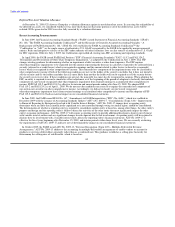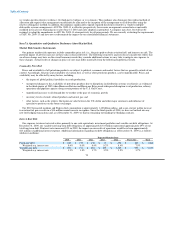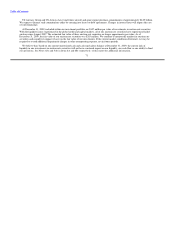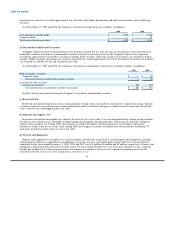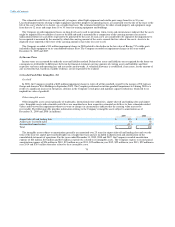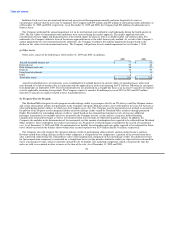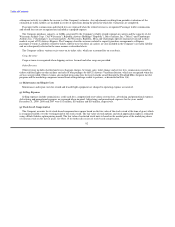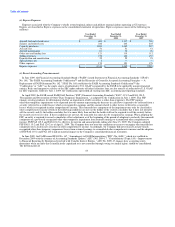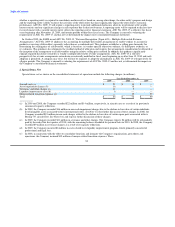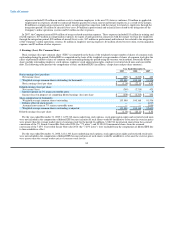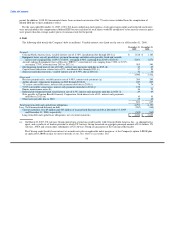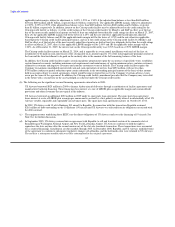US Airways 2009 Annual Report Download - page 79
Download and view the complete annual report
Please find page 79 of the 2009 US Airways annual report below. You can navigate through the pages in the report by either clicking on the pages listed below, or by using the keyword search tool below to find specific information within the annual report.
Table of Contents
US Airways Group, Inc.
Notes to Consolidated Financial Statements
1. Basis of Presentation and Summary of Significant Accounting Policies
(a) Nature of Operations and Operating Environment
US Airways Group, Inc. ("US Airways Group" or the "Company"), a Delaware corporation, is a holding company whose primary
business activity is the operation of a major network air carrier through its wholly owned subsidiaries US Airways, Inc. ("US Airways"),
Piedmont Airlines, Inc. ("Piedmont"), PSA Airlines, Inc. ("PSA"), Material Services Company, Inc. ("MSC") and Airways Assurance
Limited ("AAL"). Effective upon US Airways Group's emergence from bankruptcy on September 27, 2005, US Airways Group merged
with America West Holdings Corporation ("America West Holdings"), with US Airways Group as the surviving corporation.
The Company operates the fifth largest airline in the United States as measured by domestic revenue passenger miles ("RPMs") and
available seat miles ("ASMs"). US Airways has hubs in Charlotte, Philadelphia and Phoenix and a focus city at Ronald Reagan
Washington National Airport. US Airways offers scheduled passenger service on more than 3,000 flights daily to more than 190
communities in the United States, Canada, Mexico, Europe, the Middle East, the Caribbean, Central and South America. US Airways
also has an established East Coast route network, including the US Airways Shuttle service, with a substantial presence at Washington
National Airport. US Airways had approximately 51 million passengers boarding its mainline flights in 2009. During 2009, US Airways'
mainline operation provided regularly scheduled service or seasonal service at 138 airports, while the US Airways Express network
served 152 airports in the United States, Canada and Mexico, including 75 airports also served by the mainline operation. US Airways
Express air carriers had approximately 27 million passengers boarding their planes in 2009. As of December 31, 2009, US Airways
operated 349 mainline jets and is supported by the Company's regional airline subsidiaries and affiliates operating as US Airways Express
either under capacity purchase or prorate agreements, which operated approximately 236 regional jets and 60 turboprops.
As of December 31, 2009, US Airways employed approximately 31,300 active full-time equivalent employees. The Company's
Express subsidiaries, Piedmont and PSA, employed approximately 4,700 active full-time equivalent employees. Approximately 87% of
employees are covered by collective bargaining agreements with various labor unions. US Airways' pilots and flight attendants are
currently working under the terms of their respective US Airways or America West Airlines, Inc. ("AWA") collective bargaining
agreements, as modified by transition agreements reached in connection with the merger.
(b) Basis of Presentation
The accompanying consolidated financial statements include the accounts of US Airways Group and its wholly owned subsidiaries.
The Company has the ability to move funds freely between its operating subsidiaries to support operations. These transfers are recognized
as intercompany transactions. All significant intercompany accounts and transactions have been eliminated.
The preparation of financial statements in conformity with accounting principles generally accepted in the United States of America
requires management to make estimates and assumptions that affect the reported amounts of assets and liabilities and disclosure of
contingent assets and liabilities at the date of the financial statements and the reported amounts of revenues and expenses during the
reporting period. Actual results could differ from those estimates. The principal areas of judgment relate to passenger revenue
recognition, impairment of long-lived and intangible assets, valuation of investments in marketable securities, the frequent traveler
program and the deferred tax asset valuation allowance.
The Company evaluated subsequent events through the date the accompanying financial statements were issued, which was
February 16, 2010.
(c) Cash and Cash Equivalents
Cash equivalents consist primarily of cash in money market securities and highly liquid debt instruments. All highly liquid investments
purchased within three months of maturity are classified as cash equivalents. Cash
77




